IRS AUCTION NOW!
Bid by June 3rd
In an effort to supply builders with the most options available, we consequently have beautiful live edge slab table tops. NNT has also brought in some absolutely exquisite figured live edge slabs. These are all listed and priced on our inventory page.
We also have begun to open our mill up to more domestic species that are still very large, but a bit easier to pay for. These materials have everything from a very unique figure to interesting spalt and ambrosia. Currently we have Maple, Spalted Elm and Poplar slabs that have all been cut and are air drying.
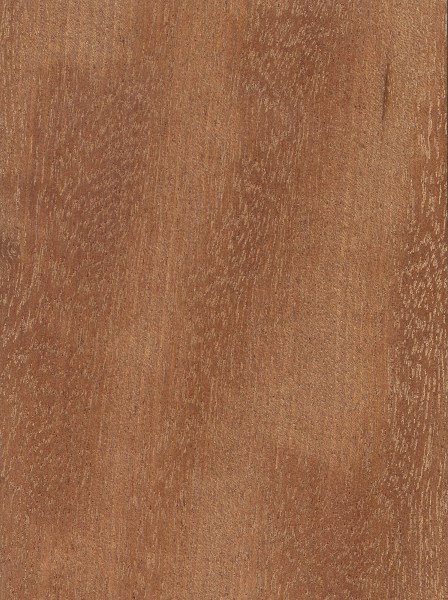
Color/Appearance: Heartwood is a rather uniform pinkish brown, sometimes darker reddish brown. Color tends to darken with age. Sapwood is grayish brown. Figured grain patterns are also seen, such as pommele, quilted, mottled, and beeswing.
Grain/Texture: Grain is straight to wavy. With a fine, even texture.
Endgrain: Diffuse-porous; solitary and radial multiples; large pores arranged in radial/diagonal pattern, few; parenchyma reticulate; narrow rays, spacing fairly close.
Rot Resistance: Rated as very durable; good insect resistance.
Workability: Generally easy to work with hand or machine tools, though figured wood is much more prone to chipping and tearout in machining operations. Also, Moabi has a high silica content, and will rapidly dull cutting edges, especially tool steel. Turns, glues, and finishes well. Responds well to steam bending.
Odor: No characteristic odor.
Sustainability: This wood species is not listed in the CITES Appendices, but is on the IUCN Red List. It is listed as vulnerable due to a population reduction of over 20% in the past three generations, caused by a decline in its natural range, and exploitation.
Common Uses: Veneer, turned objects, fine furniture, cabinetry, and small specialty items.
Comments: Sometimes called African Pear, though the wood bears little botanical relation to true Pear (Pyrus genus). Moabi is a very large African tree, frequently yielding figured lumber and veneer; not too unlike Makore.
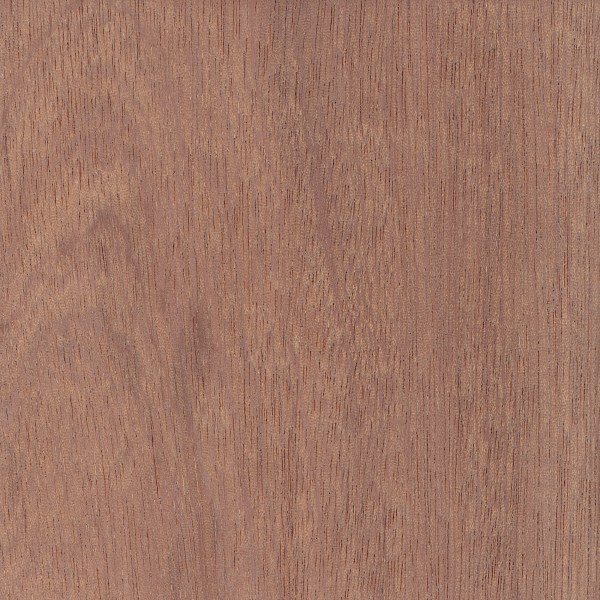
Color/Appearance: Heartwood is a medium to dark reddish brown or purplish brown. Color tends to darken with age. Besides the common ribbon pattern seen on quartersawn boards, Sapele is also known for a wide variety of other figured grain patterns, such as: pommele, quilted, mottled, wavy, beeswing, and fiddleback.
Grain/Texture: Grain is interlocked, and sometimes wavy. Fine uniform texture and good natural luster.
Endgrain: Diffuse-porous; large pores in no specific arrangement, few; solitary and radial multiples of 2-3; reddish brown deposits occasionally present; growth rings distinct due to terminal parenchyma; rays not visible without lens; apotracheal parenchyma diffuse-in-aggrregates, paratracheal parenchyma vasicentric, aliform (winged), confluent, and banded.
Rot Resistance: Heartwood ranges from moderately durable to very durable in regard to decay resistance. Sapele is susceptible to insect attack.
Workability: Sapele can be troublesome to work in some machining operations, (i.e., planing, routing, etc.), resulting in tearout due to its interlocked grain. It will also react when put into direct contact with iron, becoming discolored and stained. Sapele has a slight blunting effect on cutters, but it turns, glues, and finishes well.
Odor: Sapele has a distinct, cedar-like scent while being worked.
Sustainability: This wood species is not listed in the CITES Appendices, but is on the IUCN Red List. It is listed as vulnerable due to a population reduction of over 20% in the past three generations, caused by a decline in its natural range, and exploitation.
Common Uses: Veneer, plywood, furniture, cabinetry, flooring, boatbuilding, musical instruments, turned objects, and other small wooden specialty items.
Comments: Sapele is a commonly exported and economically important African wood species. It’s sold both in lumber and veneer form. It is occasionally used as a substitute for Genuine Mahogany, and is sometimes referred to as “Sapele Mahogany.” Technically, the two genera that are commonly associated with mahogany are Swietenia and Khaya, while Sapele is in the Entandrophragma genus, but all three are included in the broader Meliaceae family, so comparisons to true mahogany may not be too far fetched.

Color/Appearance: Heartwood color can range from a light pinkish brown to a deep reddish brown. Sapwood is a pale white/yellow.
Grain/Texture: Redwood has closed pores and a medium texture. The grain is typically straight, but may occasionally be wavy or irregular. Figure such as curly grain and/or burl clusters are occasionally seen.
Endgrain: Resin canals absent; earlywood to latewood transition abrupt, color contrast medium-high; tracheid diameter large-very large; parenchyma diffuse (usually visible with hand lens).
Rot Resistance: Rated as moderately durable to very durable regarding decay resistance. Lumber from old-growth trees tends to be more durable than that from younger second-growth trees.
Workability: Typically easy to work with hand tools or machinery, but planer tearout can occur on figured pieces with curly, wavy, or irregular grain. Glues and finishes well.
Odor: Redwood has a distinct odor when being worked.
Sustainability: This wood species is not listed in the CITES Appendices, but is on the IUCN Red List. It is listed as vulnerable due to a population reduction of approximately 40% in the past three generations, caused by a decline in its natural range, and exploitation.
Common Uses: Veneer, construction lumber, beams, posts, decking, exterior furniture, and trim. Burls and other forms of figured Redwood are also used in turning, musical instruments, and other small specialty items.
Comments: Capable of attaining heights of nearly 400 feet, Redwood (Sequoia sempervirens) is the world’s tallest tree species. It grows in a very limited area on the Pacific coast of northwestern United States, where heavy rainfall and cool, damp air create a unique environment for these trees. Redwood’s IUCN status is currently listed as vulnerable, but not endangered. A related species, (Sequoiadendron giganteum), sometimes known as Giant Sequoia or Wellingtonia, produces similar lumber.
Redwood lumber is very soft and lightweight, with a decent strength-to-weight ratio. It is also exceptionally stable, with very little shrinkage or seasonal movement. The mechanical values listed at the top of the page represent the averages between both old-growth lumber and second-growth lumber. On the whole, old-growth lumber tends to be slightly heavier (29 lbs/ft3 versus 26), harder (480 lbf Janka hardness versus 420), and stronger (10,000 lbf/in2modulus of rupture versus 7,900) than younger second-growth lumber.

Color/Appearance: Pink or reddish brown, commonly with a mottled or wavy grain pattern. Figured grain patterns are commonly seen in Makore, and include: mottled, curly, wavy, and moire.
Grain/Texture: Makore has a fine texture with closed pores. It also tends to have a natural luster and shine from its high silica content. The grain can be straight, interlocked, or wavy.
Endgrain: Diffuse-porous; medium pores predominantly in radial multiples of 2-4; tyloses and other deposits present; growth rings indistinct; rays not visible without lens; parenchyma reticulate/banded.
Rot Resistance: Heartwood is very durable, and is also resistant to insect attack.
Workability: Generally easy to work, though sections with interlocked grain can cause tearout during planing or other machining operations. Makore will react when put into direct contact with iron, becoming discolored and stained. Makore also has a pronounced blunting effect on cutters due to its high silica content. Besides this dulling effect, Makore turns well, and is easy to glue and finish.
Odor: No characteristic odor.
Sustainability: This wood species is not listed in the CITES Appendices, but is on the IUCN Red List. It is listed as endangered due to a population reduction of over 50% in the past three generations, caused by a decline in its natural range, and exploitation.
Common Uses: Veneer, plywood, furniture, cabinetry, flooring, boatbuilding, musical instruments, turned objects, and other small wooden specialty items.

Angelim Pedra is found in South America, primarily in Brazil and Guyane. The heartwood has a beautiful rich color; varying from a light orange tan to orange brown with brown vertical stripes. The sapwood is a creamy gray color.
Properties: Angelim Pedra is easy to work with both hand and machine tools and can attain a smooth finish
Uses: Because of its durability, Angelim Pedra is popular for making decking, flooring and is used in building construction. It is also a desirable wood for fine furniture making especially when wide widths are needed.
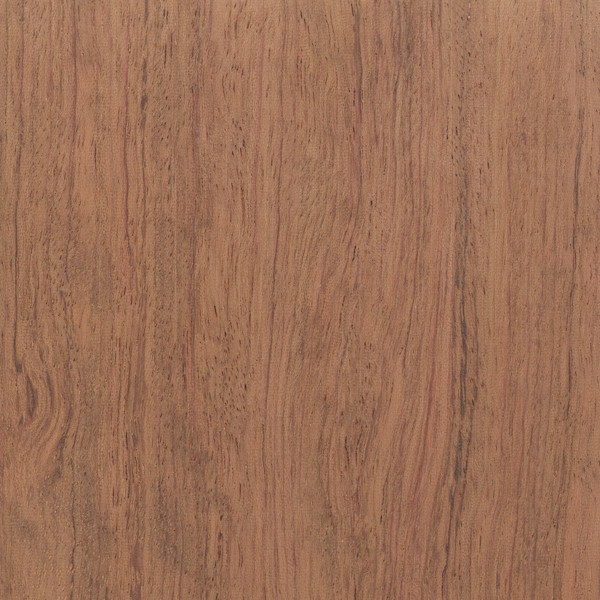
Color/Appearance: Heartwood ranges from a pinkish red to a darker reddish brown with darker purple or black streaks. Sapwood is a pale straw color and is clearly demarcated from the heartwood. Bubinga is very frequently seen with a variety of figure, including: pommele, flamed, waterfall, quilted, mottled, etc.
Grain/Texture: Grain is straight to interlocked. Has a uniform fine to medium texture and moderate natural luster.
Endgrain: Diffuse-porous; medium pores in no specific arrangement; solitary and radial multiples of 2-3; mineral deposits occasionally present; growth rings distinct due to marginal parenchyma; rays faintly visible without lens; parenchyma vasicentric, aliform, confluent, and banded (marginal).
Rot Resistance: Ranges from moderately durable to very durable depending upon the the species. Bubinga is also reported to be resistant to termite and marine borer attack.
Workability: Easy to work overall, though depending upon the species Bubinga can have silica present, which can prematurely dull cutting edges. Also, on pieces with figured or interlocking grain, tearout can occur during planing or other machining operations. Gluing can occasionally be problematic due to Bubinga’s high density and natural oils. Turns and finishes well.
Odor: Bubinga is reported to have an unpleasant scent when the lumber is still wet, which disappears after the wood is dry.
Sustainability: This wood species is not listed in the CITES Appendices or on the IUCN Red List of Threatened Species.
Common Uses: Veneer, inlays, fine furniture, cabinetry, turnings, and other specialty items. Since Bubinga trees can grow so large, natural-edge slabs of the wood have also been used in tabletops and other specialized projects.
Comments: An immensely popular imported African hardwood, Bubinga may be loved as much for its quirky name as it is for its strength and beauty. Also sometimes called Kevazingo, usually in reference to its decorative rotary-cut veneer.
Bubinga has a close resemblance to rosewood, and is often use in place of more expensive woods. Yet Bubinga also features a host of stunning grain figures, such as flamed, pommele, and waterfall, which make this wood truly unique. Bubinga also has an exceptional strength-to-weight ratio.
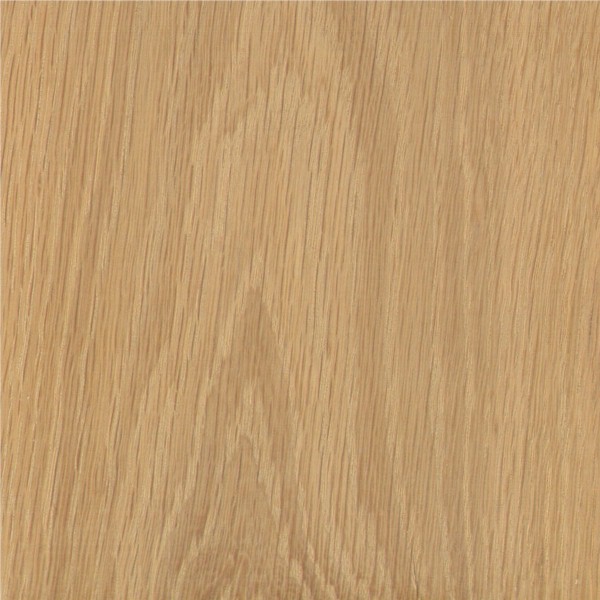
Color/Appearance: Heartwood is a light to medium brown, commonly with an olive cast. Nearly white to light brown sapwood is not always sharply demarcated from the heartwood. Quartersawn sections display prominent ray fleck patterns. Conversely, Red Oak tends to be slightly redder, but is by no means a reliable method of determining the type of oak.
Grain/Texture: Grain is straight, with a coarse, uneven texture.
Endgrain: Ring-porous; 2-4 rows of large, exclusively solitary earlywood pores, numerous small to very small latewood pores in radial arrangement; tyloses abundant; growth rings distinct; rays large and visible without lens; apotracheal parenchyma diffuse-in-aggregates (short lines between rays).
Rot Resistance: Rated as very durable; frequently used in boatbuilding and tight cooperage applications.
Workability: Produces good results with hand and machine tools. Has moderately high shrinkage values, resulting in mediocre dimensional stability, especially in flatsawn boards. Can react with iron (particularly when wet) and cause staining and discoloration. Responds well to steam-bending. Glues, stains, and finishes well.
Odor: Has a tell-tale smell that is common to most oaks. Most find it appealing.
Sustainability: This wood species is not listed in the CITES Appendices or on the IUCN Red List of Threatened Species.
Common Uses: Cabinetry, furniture, interior trim, flooring, boatbuilding, barrels, and veneer.
Comments: White Oak is the state tree of Connecticut, Illinois, and Maryland. Connecticut’s state quarter was minted with a picture and inscription of a famous White Oak tree, The Charter Oak.
White Oak is strong, beautiful, rot-resistant, easy-to-work, and economical, representing an exceptional value to woodworkers. It’s no wonder that the wood is so widely used in cabinet and furniture making.
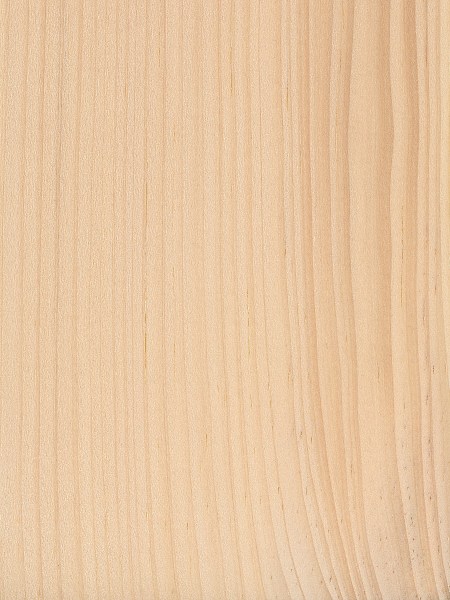
Color/Appearance: Heartwood is a light brown, sometimes with a slightly reddish hue, sapwood is a pale yellow to nearly white. Color tends to darken with age.
Grain/Texture: Grain is straight with an even, medium texture.
Endgrain: Large resin canals, numerous and evenly distributed, mostly solitary; earlywood to latewood transition gradual, color contrast fairly low; tracheid diameter medium to large.
Rot Resistance: The heartwood is rated as moderate to low in decay resistance.
Workability: Eastern White Pine is easy to work with both hand and machine tools. Glues and finishes well.
Odor: Eastern White Pine has a faint, resinous odor while being worked.
Sustainability: This wood species is not listed in the CITES Appendices, and is reported by the IUCN as being a species of least concern.
Common Uses: Crates, boxes, interior millwork, construction lumber, carving, and boatbuilding.
Comments: Eastern White Pine is one of the most common and widely used timbers for construction lumber in the northeast United States. It’s one of the three primary commercial species of White Pine, with the other two—Sugar Pine and Western White Pine—being found on the west coast.
The long, straight trunks of Eastern White Pine were once prized for use as ship masts. The king of England’s aggravating habit of marking out and reserving all the biggest and best of these trees for use in his navy lead to the Pine Tree Riot of 1772, and played a role in the events leading up to the Revolutionary War.

Color/Appearance: Heartwood is a light to medium brown, sometimes with a hint of red. Sapwood is a pale white or cream color.
Grain/Texture: Has a medium texture and moderate-sized pores. Grain is sometimes straight, but commonly interlocked.
Endgrain: Ring-porous; large to very large earlywood pores in a continuous row one or two pores wide, small latewood pores in wavy bands; tyloses occasionally present in earlywood; growth rings distinct; parenchyma vasicentric and confluent; medium rays, spacing normal.
Rot Resistance: Rated as moderately durable to non-durable in regard to heartwood decay, but is susceptible to insect attack, and living trees are very commonly destroyed by Dutch elm disease.
Workability: Can be a challenge to work because of interlocked grain, especially on quartersawn surfaces. Planing can cause tearout and/or fuzzy surfaces. Glues, stains, and finishes well. Responds well to steam bending.
Odor: Elm usually has a strong, unpleasant smell when green; though once dried has very little odor.
Sustainability: This wood species is not listed in the CITES Appendices or on the IUCN Red List of Threatened Species.
Common Uses: Boxes, baskets, furniture, hockey sticks, veneer, wood pulp, and papermaking.
Comments: Elm trees are commonly infected with Dutch elm disease, a fungal disease spread by elm bark beetles. D.E.D. has wiped out millions of Elm trees worldwide.
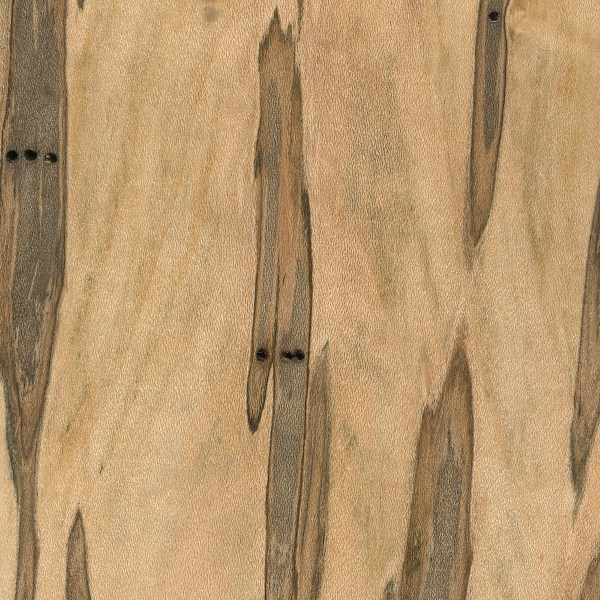
Much like Spalted Maple and other forms of figured maple, Ambrosia Maple is technically not a specific species of Maple, but rather a general description of any type of Maple that has been infested by ambrosia beetles. The beetles bore into the tree, and with it bring fungus that discolors the wood.
Ambrosia Maple is considered a decorative feature which gives the wood additional character, and is sometimes available for purchase. A special thanks to Mike Leigher for providing the wood sample of this wood species.
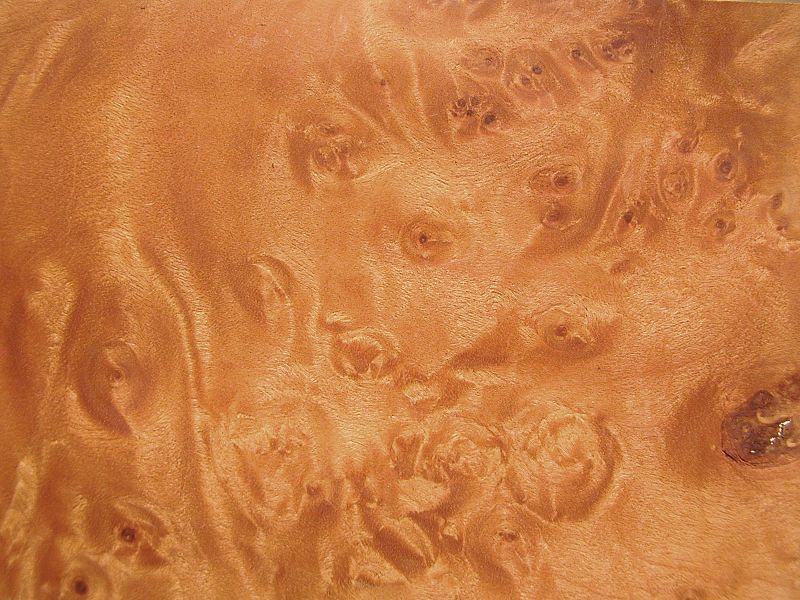
Burls yield a very peculiar and highly figured wood, prized for its beauty and rarity. It is sought after by furniture makers, artists, and wood sculptors. There are a number of well-known types of burls (each from a particular species); these are highly valued and sliced into veneers for furniture, inlay in doors, picture frames, household objects, automobile interior paneling and trim, and woodturning. The famous birdseye maple of the sugar maple (Acer saccharum) superficially resembles the wood of a burl but is something else entirely. Burl wood is very hard to work with hand tools or on a lathe because its grain is twisted and interlocked, causing it to chip and shatter unpredictably. This “wild grain” makes burl wood extremely dense and resistant to splitting, which made it valued for bowls, mallets, mauls and “beetles” or “beadles” for hammering chisels and driving wooden pegs.
Some burls are more highly prized than others, including ones from rural areas in central Massachusetts, northeast Connecticut, and as far south as Philadelphia. Some resemble an explosion in which the grain grows erratically, and it is these burls that the artist prizes over all other types. These spectacular patterns enhance the beauty of wood sculptures, furniture, and other artistic productions.
Burls are harvested with saws or axes for smaller specimens and timber felling chainsaws and tractors for massive ones.
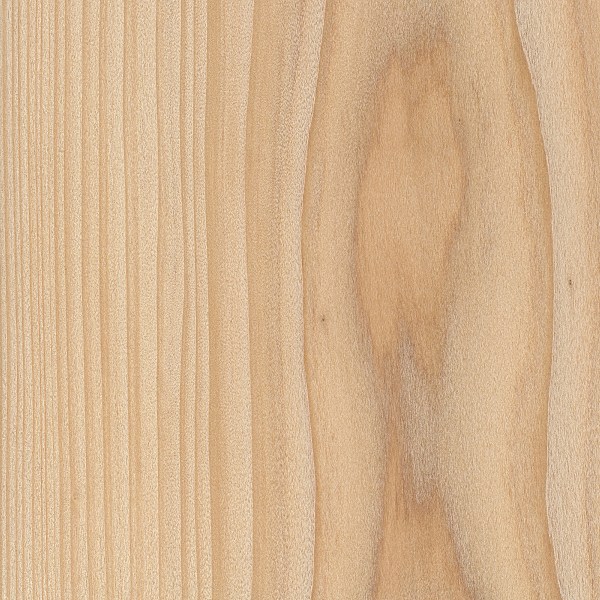
Color/Appearance: Color tends to be a light, yellowish brown. Sapwood is nearly white. Some boards can have scattered pockets of darker wood that have been attacked by fungi, which is sometimes called pecky cypress.
Grain/Texture: Cypress has a straight grain and a medium texture.
Endgrain: Resin canals absent; earlywood to latewood transition abrupt, color contrast medium; tracheid diameter large to very large.
Rot Resistance: Old-growth Cypress is rated as being durable to very durable in regards to decay resistance, while wood from younger trees is only rated as moderately durable.
Workability: Overall, Cypress is easy to work with hand and machine tools, though sharp cutters ought to be used to prevent lifting of the grain. Also, the wood has been reported by some sources to have a moderate dulling effect on cutting edges. Cypress has good gluing, nailing, finishing, and paint-holding properties.
Odor: Cypress has a distinct, somewhat sour odor while being worked.
Sustainability: This wood species is not listed in the CITES Appendices, and is reported by the IUCN as being a species of least concern.
Common Uses: Exterior construction, docks, boatbuilding, interior trim, and veneer.
Comments: Cypress is popular choice in construction applications where decay resistance is needed.
Cypress trees develop unique aerial roots that protrude above the ground (or water), and are especially seen on trees growing in swamps. These structures are known as knees, and are sometimes harvested (on a small scale) and sold for woodcarving purposes.
Pecky Cypress: Condition caused by a fungal attack that leaves long, narrow burrows or cavities in the wood. The fungus attacks mostly older cypress trees from the “canapy” or “umbrella” down. Once the tree is cut down, or harvested, the fungal attack stops, leaving the beautiful, unique pecky patterns.
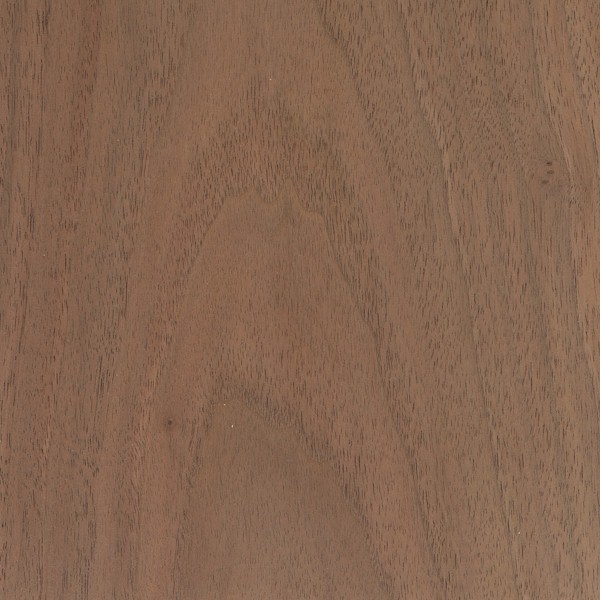
Color/Appearance: Heartwood can range from a lighter pale brown to a dark chocolate brown with darker brown streaks. Color can sometimes have a grey, purple, or reddish cast. Sapwood is pale yellow-gray to nearly white. Figured grain patterns such as curl, crotch, and burl are also seen.
Grain/Texture: Grain is usually straight, but can be irregular. Has a medium texture and moderate natural luster.
Endgrain: Semi-ring-porous; large earlywood pores grading to medium latewood pores, few; solitary and radial multiples of 2-3; tyloses occasionally to abundantly present; growth rings distinct; rays barely visible without lens; parenchyma banded (marginal), apotracheal parenchyma diffuse-in-aggregates (sometimes very faint and barely visible even with lens).
Rot Resistance: Black Walnut is rated as very durable in terms of decay resistance, though it is susceptible to insect attack.
Workability: Typically easy to work provided the grain is straight and regular. Planer tearout can sometimes be a problem when surfacing pieces with irregular or figured grain. Glues, stains, and finishes well, (though walnut is rarely stained). Responds well to steam bending.
Odor: Black Walnut has a faint, mild odor when being worked.
Sustainability: This wood species is not listed in the CITES Appendices or on the IUCN Red List of Threatened Species.
Common Uses: Furniture, cabinetry, gunstocks, interior paneling, veneer, turned items, and other small wooden objects and novelties.
Comments: It would be hard to overstate Black Walnut’s popularity among woodworkers in the United States. Its cooperative working characteristics, coupled with its rich brown coloration puts the wood in a class by itself among temperate-zone hardwoods. To cap it off, the wood also has good dimensional stability, shock resistance, and strength properties.

Color/Appearance: Heartwood is light cream to yellowish brown, with occasional streaks of gray or green. Sapwood is pale yellow to white, not always clearly demarcated from the heartwood. Can also be seen in mineral stained colors ranging from dark purple to red, green, or yellow, sometimes referred to as Rainbow Poplar. Colors tend to darken upon exposure to light.
Grain/Texture: Poplar typically has a straight, uniform grain, with a medium texture. Low natural luster.
Endgrain: Diffuse-porous; small pores in no specific arrangement; solitary and radial multiples of 2-3; tyloses occasionally present; growth rings distinct due to marginal parenchyma and noded rays; rays not visible without lens; parenchyma banded (marginal).
Rot Resistance: Heartwood is rated as being moderately durable to non-durable; susceptible to insect attack.
Workability: Very easy to work in almost all regards, one of Poplar’s only downsides is its softness. Due to its low density, Poplar can sometimes leave fuzzy surfaces and edges: especially during shaping or sanding. Sanding to finer grits of sandpaper may be necessary to obtain a smooth surface.
Odor: No characteristic odor.
Sustainability: This wood species is not listed in the CITES Appendices or on the IUCN Red List of Threatened Species.
Common Uses: Seldom used for its appearance, (except in the case of Rainbow Poplar), Poplar is a utility wood in nearly every sense. It’s used for pallets, crates, upholstered furniture frames, paper (pulpwood), and plywood. Poplar veneer is also used for a variety of applications: either dyed in various colors, or on hidden undersides of veneered panels to counteract the pull of the glue on an exposed side that has been veneered with another, more decorative wood species.
Comments: Poplar is one of the most common utility hardwoods in the United States. Though the wood is commonly referred to simply as “Poplar,” it is technically not in the Populus genus itself, (the genus also includes many species of Cottonwood and Aspen), but is instead in the Liriodendron genus, which is Latin for “lily tree.” The flowers of this tree look similar to tulips, hence the common alternate name: Tulip Poplar.

Color/Appearance: Color tends to be a golden to dark brown, sometimes with darker streaks. Sapwood is usually thin and yellow/white, clearly demarcated from the heartwood. Monkeypod is sometimes seen with highly figured curly or wild grain patterns.
Grain/Texture: Grain is usually straight, but can also be interlocked or wavy. Texture is medium to coarse, with medium to large open pores and a moderate natural luster.
Endgrain: Diffuse-porous; large to very large pores in no specific arrangement, very few to few; solitary and radial multiples of 2-3; heartwood deposits occasionally present; narrow rays usually not visible without lens, normal spacing; parenchyma vasicentric, lozenge, and confluent.
Rot Resistance: Rated as durable to very durable regarding decay resistance, Monkeypod is also resistant to most insect attacks.
Workability: Monkeypod is generally easy to work with both hand and machine tools, though any interlocked grain may result in fuzzy or torn grain during planing operations. Glues and finishes well.
Odor: No characteristic odor.
Sustainability: This wood species is not listed in the CITES Appendices or on the IUCN Red List of Threatened Species.
Common Uses:Veneer, plywood, millwork/trim, carving, cabinetry, furniture, musical instruments (guitars and ukuleles), and other small specialty wood items.
Comments: So named for the spiral-shaped fruit pods which the tree bears. Outside of Hawaii, one of the most common names for the species is Raintree, which is due to the leaves’ tendency to fold up at night or during periods of rainfall, allowing rain to pass through its broad canopy to the vegetation below. Trees are commonly planted in tropical regions as an ornamental shrub or shade tree.
Monkeypod is called by many different names in many different cultures, and its lumber is likewise used for a number of different purposes depending on the locale, ranging from utility wood and construction purposes to fine furniture.

Color/Appearance: Heartwood is light to medium reddish brown. Paler sapwood is usually well defined. Burls of English Elm are frequently referred to as Carpathian Elm burl.
Grain/Texture: Grain is interlocked (making it very resistant to splitting). With a somewhat coarse, uneven texture.
Rot Resistance: Rated as non-durable; susceptible to insect attack. Living trees are susceptible to Dutch elm disease.
Workability: Can be a challenge to work because of interlocked grain, especially on quartersawn surfaces. Planing can cause tearout and/or fuzzy surfaces. Poor dimensional stability. Glues, stains, and finishes well. Responds well to steam bending, and holds nails and screws well.
Odor: Elm usually has a strong, unpleasant smell when green; though once dried has very little odor.
Sustainability: This wood species is not listed in the CITES Appendices or on the IUCN Red List of Threatened Species.
Common Uses: Boxes, baskets, furniture, hockey sticks, veneer, archery bows, and paper (pulpwood).
Comments: Elm trees are commonly infected with Dutch elm disease, a fungal disease spread by elm bark beetles. D.E.D. has wiped out millions of Elm trees worldwide.
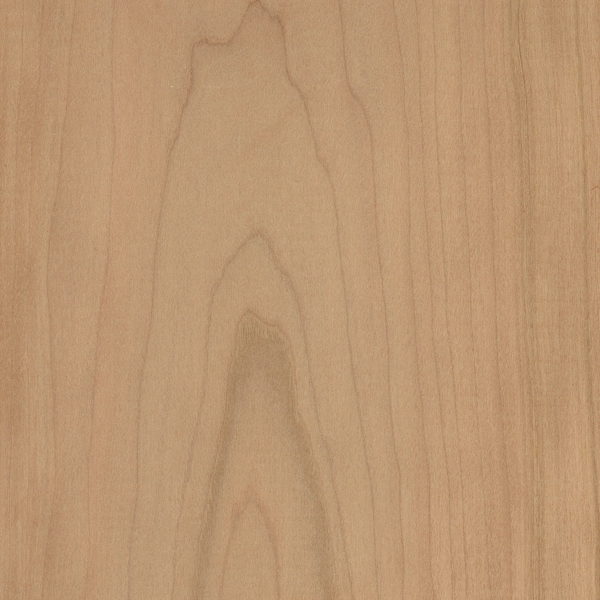
Color/Appearance: Heartwood is a light pinkish brown when freshly cut, darkening to a deeper golden brown with time and upon exposure to light. Sapwood is a pale yellowish color.
Grain/Texture: Has a fine texture with close grain. The grain is usually straight and easy to work—with the exception of figured pieces with curly grain patterns.
Endgrain: Semi-ring-porous to diffuse-porous; small pores in no specific arrangement; solitary and radial multiples of 2-3; mineral/gum deposits occasionally present; growth rings usually distinct due to a concentration of earlywood pores; rays visible without lens; parenchyma absent.
Rot Resistance: Heartwood is rated as being very durable and resistant to decay.
Workability: Cherry is known as being one of the best all-around woods for workability. It is stable, straight-grained, and machines well. The only difficulties typically arise if the wood is being stained, as it can sometimes give blotchy results due to its fine, closed pores.
Odor: Has a mild, distinctive scent when being worked.
Sustainability: This wood species is not listed in the CITES Appendices or on the IUCN Red List of Threatened Species.
Common Uses: Cabinetry, fine furniture, flooring, interior millwork, veneer, turned objects, and small specialty wood items.
Comments: Black Cherry develops a rich reddish-brown patina as it ages that’s frequently imitated with wood stains on other hardwoods such as Yellow Poplar (Liriodendron tulipifera). This aging process can be accelerated by exposing the wood (in a judicious manner) to direct sunlight.”